Table of Contents
Hey there, tattoo enthusiasts, artists, and everyone else who just stumbled here out of curiosity – it’s Tori coming at you with another insightful dive into the mesmerizing world of ink! Now, don’t squirm, we’re going to unravel something many of you have pondered over – “How long should I keep my tattoo wrapped?”
If you’re expecting a one-liner answer, let me stop you right there. This isn’t a simple question. To truly understand it, we need to swim a bit in the pool of tattoo history, symbolism, and its vibrant cultural and artistic influences. You’re in for a ride!
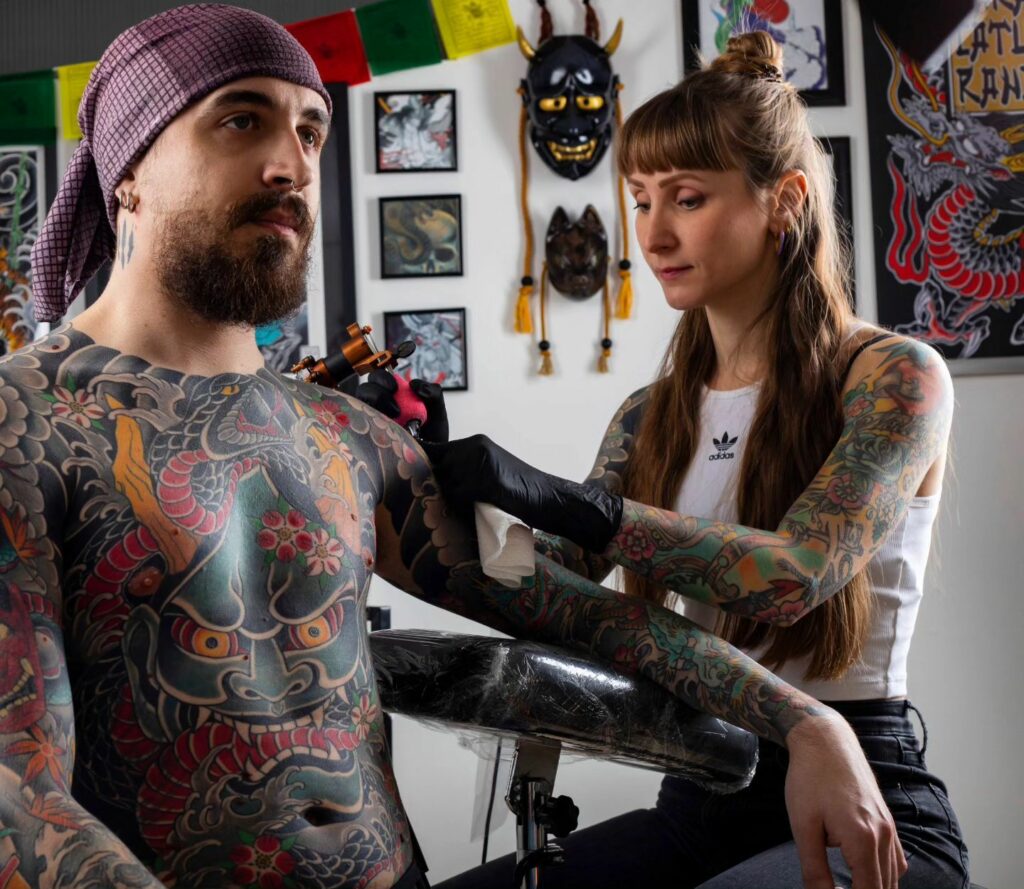
Tattoos are no longer just the signs of sailors, bikers, or rebels without causes. They’ve stormed into mainstream culture with a rich history in their wake. From the intricate tribal markings of ancient Polynesians to the revered Irezumi of Japan, every design has a tale to tell, and every wrap, a purpose to serve.
In this post, we’ll venture beyond the mere aesthetics, pulling back the veil to reveal the very soul of tattoos and the art of aftercare. It’s not about slapping on a piece of plastic and calling it a day – there’s an entire science and art behind it. We’ll decode the intricacies of healing, the symbolism of the wrap, and its vital role in the life of your tattoo, imbued with the traditions that shaped it over centuries.
So, whether you’re a freshly inked newbie still smelling of antiseptic, an experienced tattoo collector, or simply an intrigued cat with questions, stick around. This might just be the most riveting rabbit hole you’ll jump into today!
But remember, folks, knowledge without humor is like a tattoo needle without ink. So, prepare yourself for some laughs, a few groans, and a whole lot of learning, as we wrap and unwrap the fascinating saga of tattoo aftercare!
In this fun and insightful article, we’ll demystify the function of the wrap, its varieties, and its significant role in your tattoo’s healing process. Prepare for some exciting pros and cons analysis, and handy tips for you to keep in mind. So, are you ready? Then let’s roll!
What is the tattoo wrap?
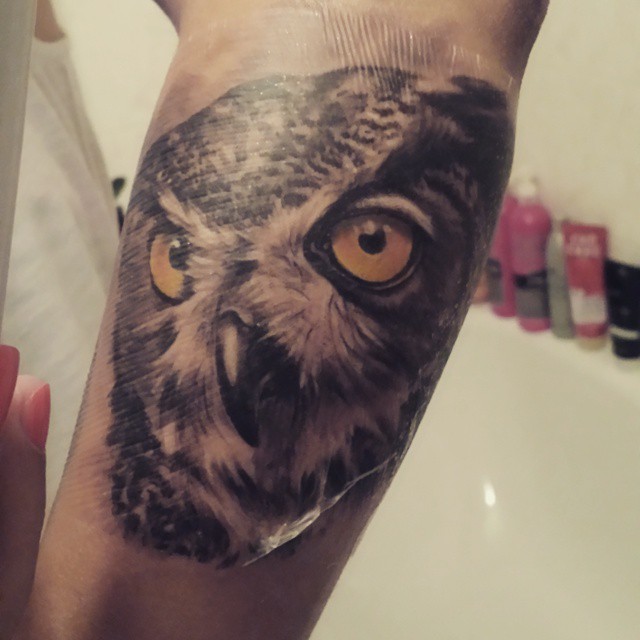
Picture this – you’ve just got an amazing piece of art etched onto your skin. Now, before you step out to flaunt it, your artist covers it with a sterile material known as a tattoo wrap. Its job? Protect your fresh ink from any bacteria, knocks, or impacts. It’s the knight in shiny plastic that shields your tattoo while it’s healing, and the new skin layer starts forming.
Remember how your mom would always put a bandage over your scrapes and cuts when you were little? That’s exactly what your wrap is doing – safeguarding your ink until it’s ready to face the world.
How long should I keep my tattoo wrapped?
You might be wondering, “Alright, Tori, but how long do I keep this wrap on?” I get this question a lot. The short answer is, if you’re using simple cling wrap, keep it on for about 2-4 hours. If it’s a protective tattoo film, you’re looking at 3-5 days.
Remember the first tattoo I ever did? It was on my college roommate, and I naively thought it was best to keep the wrap on for days. Let’s just say that the results were less than stellar, and I learnt my lesson!

All you need to know about the wrapping process
So here’s a little walk-through of what happens when your tattoo gets wrapped. First, your artist will sanitize the tattoo area using an antibacterial cleanser or mild soap. Once the area is sterile and dry, your artist will then cover it with a professional tattoo film or a simple plastic foil, marking the beginning of the healing phase. And just like that, you’ve started your aftercare journey!
Should I wrap the tattoo at night?
During my early days as a tattoo artist, I used to get midnight panic calls from clients asking if they should keep their wraps on overnight. Let me put your worries to rest: it’s usually a good idea to keep the tattoo wrapped up during the first night, especially if it’s going to rub against your sheets. But remember, if you’re ever in doubt, just give your artist a shout!
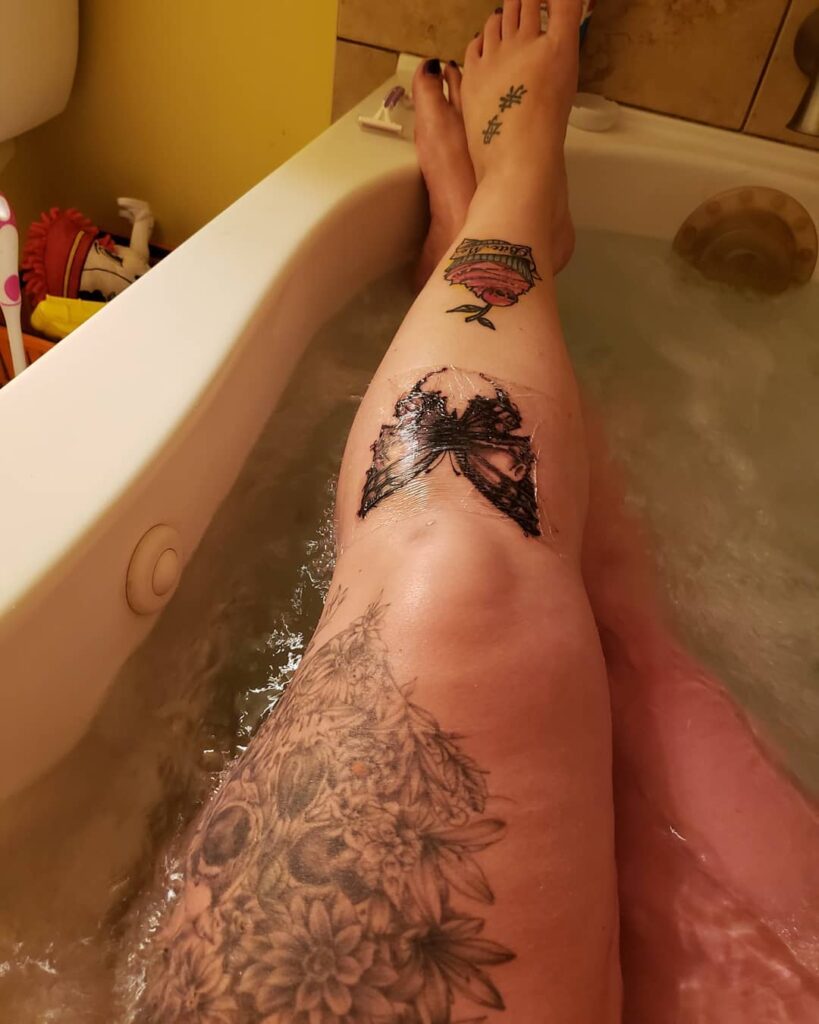
Can I re-wrap my new tattoo?
Now comes a hot topic in the tattoo community: the great re-wrap debate. In my experience, most artists, including myself, discourage self-rewrapping after you’ve removed the original wrap. Here’s why – your home, while comfy and cozy, isn’t as sterile as a tattoo studio. You wouldn’t want to risk bacteria having a party between your skin and the new wrap, would you?
Protective tattoo film VS plastic foil (cling wrap): pros & cons
Originally, simple cling wrap was the go-to material for tattoo aftercare. But tattoo tech has evolved, and we now have a new player in town – the protective tattoo film. This self-adhesive film has been gaining popularity among artists worldwide for its superior protection and comfort. But let’s not write off cling wrap just yet! Here’s my take on the pros and cons of each:

Protective Tattoo Film
Pros:
- Breathable and flexible, allowing for a faster healing process.
- Shower-friendly, making it ideal for people with active lifestyles.
Cons:
- Possible allergic reactions to the adhesive components (though it’s rare!).
Cling Wrap (Plastic Foil)
Pros:
- Budget-friendly and easily accessible.
- Effective as a short-term barrier against germs.
Cons:
- Doesn’t allow the skin to breathe as well as the protective film.
- Feels uncomfortable and rigid on the skin.
Despite their differences, both these options effectively shield your fresh ink from unwanted infections. But having used protective film, I must admit it’s hard to go back to cling wrap!
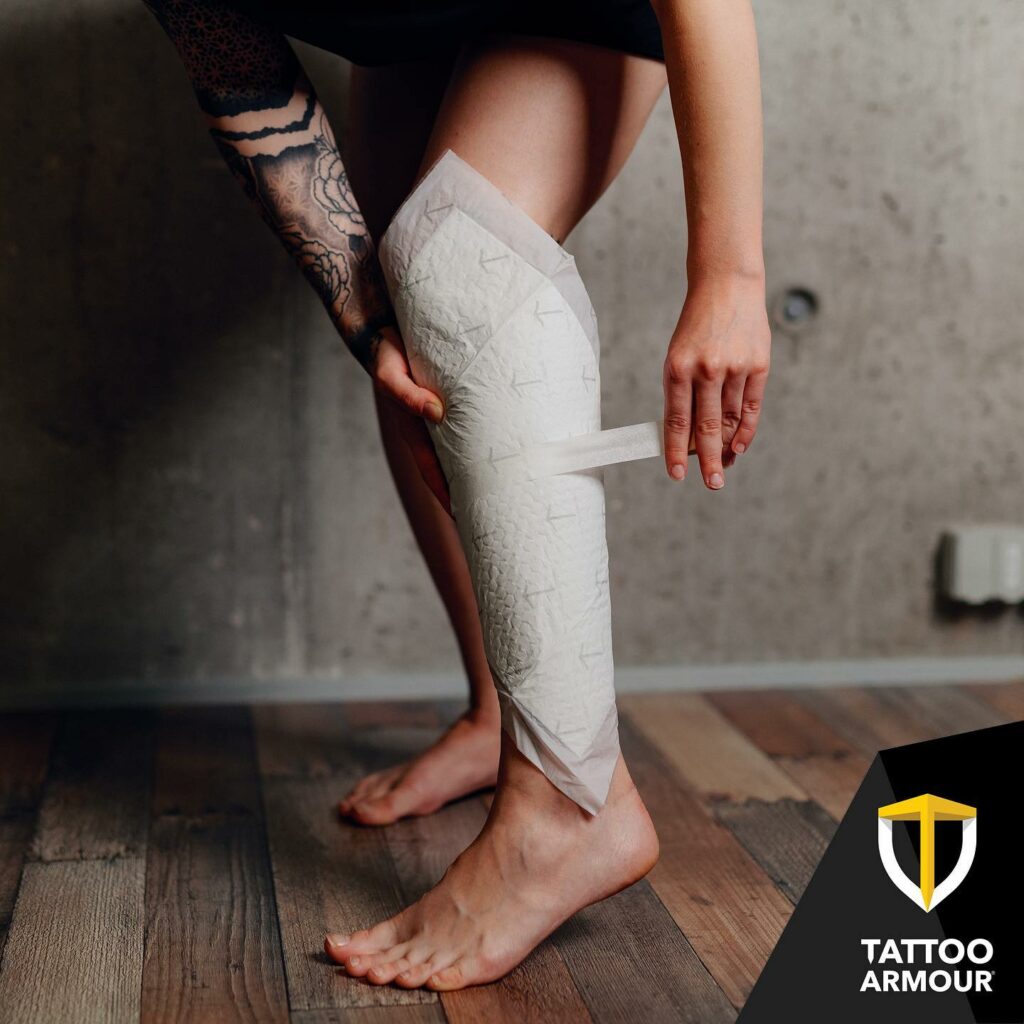
Is it safe to leave a tattoo bandage on too long?
Contrary to popular belief, keeping your tattoo wrapped for too long isn’t doing your skin any favors. It can actually lead to infections and delay the healing process. Trust me, I learned this the hard way with a client who insisted on keeping the wrap on for an extra day or two. The result? Let’s just say it wasn’t pretty. So, remember to change your wrap regularly and let your skin breathe.
What to Do After Uncovering a Tattoo
Once you’ve unwrapped your tattoo, the real aftercare process begins. It’s a little like nursing a baby bird to health – you’ll need to clean the area with mild soap 2-3 times a day, apply a water-based ointment, and avoid direct sunlight. And for heaven’s sake, don’t pick at the scabs!
In a nutshell, healing will take around two to four weeks. However, the skin might take a few months to fully recover, so make sure to stay in touch with your tattoo artist for any advice or assistance you might need.
Main advantages of wrapping the tattoo
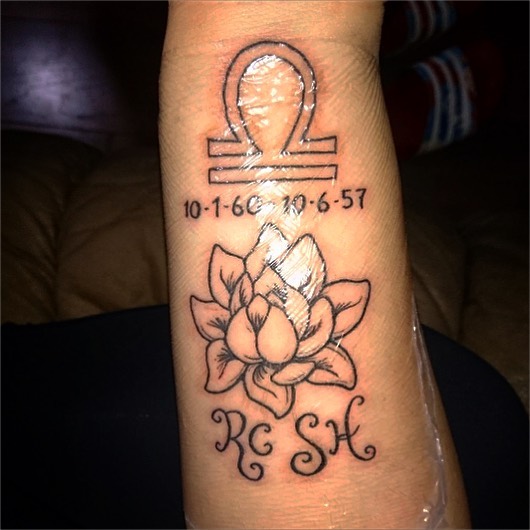
The wrap, while humble in appearance, plays a crucial role in your tattoo healing journey. It shields your new tattoo from bacteria and infections, creates an optimal environment for healing, and prevents irritants like rough clothing from damaging your ink. So, next time you get a tattoo, you’ll know the importance of this unsung hero in your aftercare routine.
How long should I keep my tattoo covered with cling film?
“Hey, Tori, how long should I keep my tattoo wrapped?” This is probably one of the most common queries I get. The answer depends on what you’ve got covering your fresh ink. If you’ve been wrapped in simple cling film, the general rule of thumb is to keep it on for about 2-4 hours post-tattoo. However, if you’ve got a protective tattoo film on, you can confidently wear it for a good 3-5 days.
I still remember the first time I learned about the protective film. I was at a tattoo convention, and an artist from another booth mentioned it. I was skeptical at first, but once I tried it, there was no going back!
Should I keep my tattoo wrapped for 5 days?
Aha, here comes a hot potato! “Should I keep my tattoo wrapped for 5 days?” If you’re sporting a protective tattoo film, then a big YES! These films are designed to be worn longer, providing protection and promoting healing for up to 3-5 days.
Remember the time when my best friend got her first tattoo? She was so paranoid about messing it up that she wore her protective film for a full 5 days. And guess what? It healed beautifully!
Should I cover my tattoo when I sleep?

Now let’s dive into the dilemma that keeps tattoo newbies up at night: “Should I cover my tattoo when I sleep?” You can rest easy, my friend! Keeping your tattoo wrapped during your first night is usually a wise move. This little precaution helps protect your new skin layer from friction that could happen while you’re off in dreamland.
I still giggle thinking about the night when I got my third tattoo. I was so tired that I fell asleep without rewrapping it. Waking up to an imprint of my tattoo on the sheets was not the morning surprise I was hoping for!
Is it OK to wear clothes over a new tattoo?
Fashion meets tattoos – a stylistic combo that can be a little tricky in the initial stages. Can you wear clothes over a new tattoo? Of course, you can, but remember, it’s all about the fit! Loose, comfortable clothing is your best friend for the first two weeks of the healing process. Tight clothing can interfere with the recovery, so give your skin some space to breathe.
I learned this one the hard way when I got a large piece on my thigh. Being the jeans-lover that I am, I tried squeezing into my favorite pair the next day. Let’s just say, it was not a fun experience. Trust me on this one!
Some Other Aftercare Tips For Your New Tattoo?
Absolutely! Proper aftercare is vital to ensuring your new tattoo heals beautifully and remains vibrant for years to come. Here are some additional tips for tattoo aftercare:
1. Avoid Swimming and Soaking: Stay away from swimming pools, hot tubs, saunas, and baths for at least two weeks after getting your tattoo. Water can carry bacteria, which can potentially lead to infections. Plus, prolonged exposure to water can fade your tattoo.
2. Keep It Moisturized: Use a mild, unscented lotion or a specially designed tattoo moisturizer to keep the area hydrated. Dry skin can lead to itchiness, peeling, and cracking which can damage your tattoo.
3. Sun Protection: Once your tattoo is healed, always apply a high-SPF sunscreen when going outside. Sun exposure can fade your tattoo over time.
4. Watch out for Signs of Infection: Be on the lookout for unusual redness, swelling, pus, or persistent pain. These could be signs of infection and should be addressed by a medical professional immediately.
5. Resist the Urge to Scratch or Pick: Your tattoo will itch and may even peel during the healing process. This is entirely normal! However, scratching or picking at your tattoo can cause damage, leading to patchy color or scarring.
6. Stay Hydrated and Eat Well: Your overall health impacts your healing process. Stay hydrated and eat a balanced diet to give your body the nutrients it needs to heal.
7. No Shaving or Waxing: Avoid shaving or waxing the area around your tattoo until it is fully healed. Hair removal can cause irritation and possibly introduce bacteria to the area.
8. Regular Check-ins: Especially for larger pieces, regular check-ins with your tattoo artist can help identify any issues early. It’s also a great way to build a relationship with your artist for future work.
Remember, each person’s body is unique, and so is the healing process. Listen to your body and don’t hesitate to reach out to your tattoo artist or medical professional if something doesn’t feel right.
Conclusion
As we draw this inky journey to a close, let’s not forget to address two essential aspects – tattoo placement and cost. Every person’s body is a unique canvas and finding the perfect spot for your tattoo is a personal journey. Popular places such as the forearm, shoulder, or ankle might be a good starting point for beginners due to their ease of care and lower pain levels. As for the cost, remember that a quality tattoo is an investment. Depending on the size, design complexity, and the artist’s reputation, costs can range widely. Be prepared to spend anything from a couple of hundred to several thousand dollars for an exceptional piece of art.
However, it’s not all roses in the world of tattoos. Potential risks such as allergic reactions, skin infections, or complications in MRI scans do exist. To mitigate these, ensure you choose a reputable artist, follow the aftercare instructions to the tee, and inform your medical professionals about your tattoo during check-ups.
All in all, tattoos are a beautiful expression of personal narratives and identities. But remember, they are also a lifelong commitment that requires careful thought and consideration. As with any significant decision, knowledge is power, and I hope our journey today has left you feeling a bit more informed and confident as you contemplate your next piece of body art.




